THE discoveries of royal tombs at Ur by Mr. Woolley during the seventh campaign of the Joint Expedition have come near to rivalling those of last year. Next to the tomb and the death pit, Mr. Woolley has now found traces of a shaft connecting pit and surface and expects that new facts will support his theory.
Mr. Mallowan arrived at Ur on the tenth of December and was charged with the clearing of the chambers along the front of the Nannar temple. The Rev. E. R. Burrows and Mrs. Woolley completed the staff.
L.L.
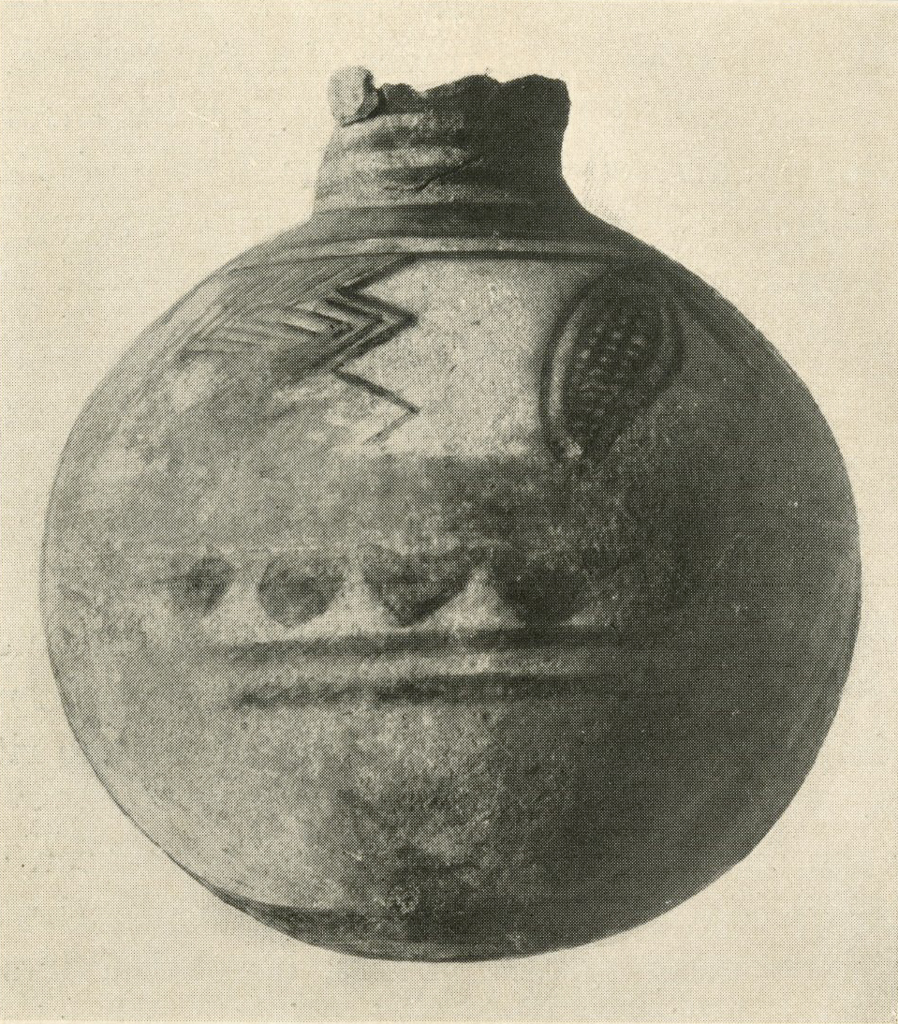
Image Number: 191135
Stratification
The first month of our new season at Ur has not indeed produced treasures to eclipse those of last winter, when we discovered the tombs of the ancient kings with their wealth of gold and their array of human victims, but it has brought us, together with many objects of first class importance, more information about the ritual of those royal funerals.
All over the cemetery the upper levels have been disturbed by the grave diggers of a later period and in half of the area worked by us during November grave robbers, house builders, and layers of drains had made havoc of the site, but in the other half conditions were simpler and it was possible to observe as never before the vertical relations between successive strata; factors which elsewhere had vanished altogether or survived only as isolated and meaningless fragments we could here connect into a scheme. Here the evidence on the whole strongly corroborates the chronological scheme suggested by me two years ago; the Sargonid graves are clearly distinguished by the types of pottery and weapons, etc., the First Dynasty graves come close to these in level and have often been disturbed by them, and then after a comparatively barren stratum come those of the early series with their distinctive furniture. Certain modifications of my previous arguments are enforced by observations made under better conditions, but the main thesis seems to hold good.
One grave which I would assign to the latter part of the early period contained an object of very great value for comparative dating—a complete painted clay vase of the later Jemdet Nasr type. This is the only example of this ware yet encountered by us. It must be an importation at a time when Sumerian pottery was exclusively monochrome and it appears to support the view I have already put forward that the Jemdet Nasr ware is northern and Akkadian, not Sumerian, and that in the north its manufacture continued until the native Akkadian culture had been swamped by the Sumerian, i. e., until the rise of the First Dynasty of Erech if not until that of the First Dynasty of Ur. At any rate it must mean that the Jemdet Nasr culture, though earlier, is not much earlier than that of our first series of graves.
First Shaft: Death Pit with Forty Bodies
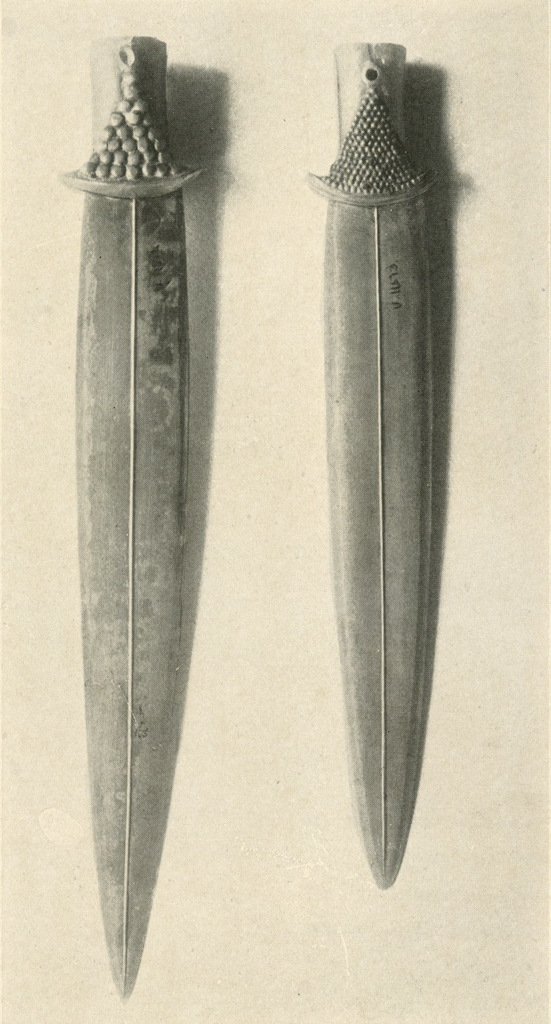
Museum Object Numbers: 30-12-550
Image Number: 191233, 9013
Last year we recovered the ground plan of a king’s grave; this year we have traced the sections of such graves and they are hardly less illuminating. The first clue was given by the discovery, not very deep down, of a layer of reeds extending up to the mud brick walls of what seemed to be a small room. The reeds were removed and under them, crushed to fragments by the weight of the soil, were innumerable clay pots, animal bones, and several human skeletons, all lying on a floor of beaten clay. It was easy to recognize that these things had been buried from the outset, were in fact an underground votive deposit, and that the building which contained them was a subterranean building; closer examination showed behind the walls an earth face cut at a gentle slope, so that the building lay in a vertical shaft. The theory arose that at the bottom of that shaft there would be a royal tomb and that when the king had been buried and his retainers duly slaughtered around him and the earth thrown back above their bodies then at intervals votive offerings would be laid in with the earth and at a certain stage the filling in of the shaft would be stopped and a chamber or chambers would be constructed in it to receive the last offerings; then more earth would be poured in and perhaps a superstructure in the form of a funerary chapel would complete the whole. So much for the theory; in fact we have dug down some twenty feet below the layer of pots, finding every now and then a fresh group of offerings or a subsidiary burial, and at the bottom we have found not indeed the tomb chamber of the king, which must lie under the mass of soil not yet excavated, but the ” death pit ” inseparable from it; in this open part of the shaft measuring less than twenty feet by ten, there are crowded, more or less in ordered rows, the bodies of thirty-nine women and one man.
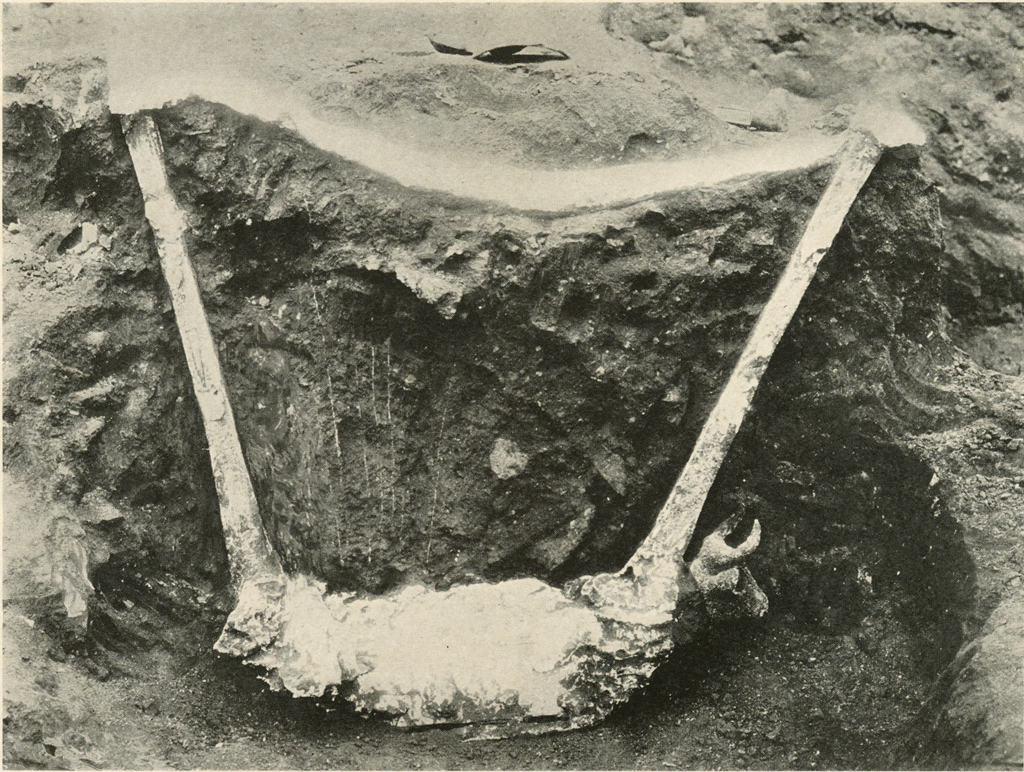
Second Shaft: Seal of Mes-Kalam-Dug
Another shaft opened more sensationally with a wooden box in which were two daggers with gold blades and gold-studded handles and a cylinder seal inscribed “ponmMes-kalam-dug the King”, a relative, one must suppose, of that prince Mes-kalam-dug whose gold helmet was the glory of our last season. As the previous grave has produced the seal of a woman bearing the title “Dam-kalam-dug” — “the wife of the good land “—it must be supposed that kalam-dug is part either of a title or of a family name. Immediately below this came a coffin burial with stone and copper vessels and a mass of clay vessels extending over the whole brick building which was now found to occupy the pit; then more layers of votive pots and more subsidiary burials, all separated by floors of beaten clay or by strata of clean earth. There followed a long blank which made us fear that we might have lost the clue, but the shaft continued; in opposite corners of it there appeared heaps of wood ash and, lower down, clay cooking pots and animal bones, the relics of a funeral feast or sacrifice made in the pit itself. The reason for the fires being precisely at the level at which they were found soon became obvious, for half way between them were found lumps of limestone set in clay mortar which spread outwards and downwards until from a border of carefully smoothed clay there rose intact the stone roof of a domed subterranean chamber, corbel-built of limestone rubble set in clay mortar: a little above the springers, holes through the masonry containing remains of wood showed that a solid centering had been employed for the construction of the central part of the dome, the stones being laid in position over a heap of light earth and straw carried by beams and matting. On the flat space round the dome funeral fires had been lit and had burnt for some time before the shaft was filled in for the construction of the subterranean building higher up. With the ashes of the fire were mixed animal bones.
The domed building had been constructed at one end of a pit dug at the bottom of the main shaft, three of its walls being against the pit’s sides and one, in which was the door, open to the court reserved in the prolongation of the shaft; this door had been blocked with large stones. Apart from a certain amount of natural subsidence, walls, dome and door were intact, though the latter was very difficult to detect, so closely did its blocking resemble the rough wall face, while the shifting of stones had disguised the outlines of the doorway. Through the beam holes it was possible to see that the floor was covered with some object of panelled wood, through the decayed remains of which protruded several large copper vessels and one of gold.
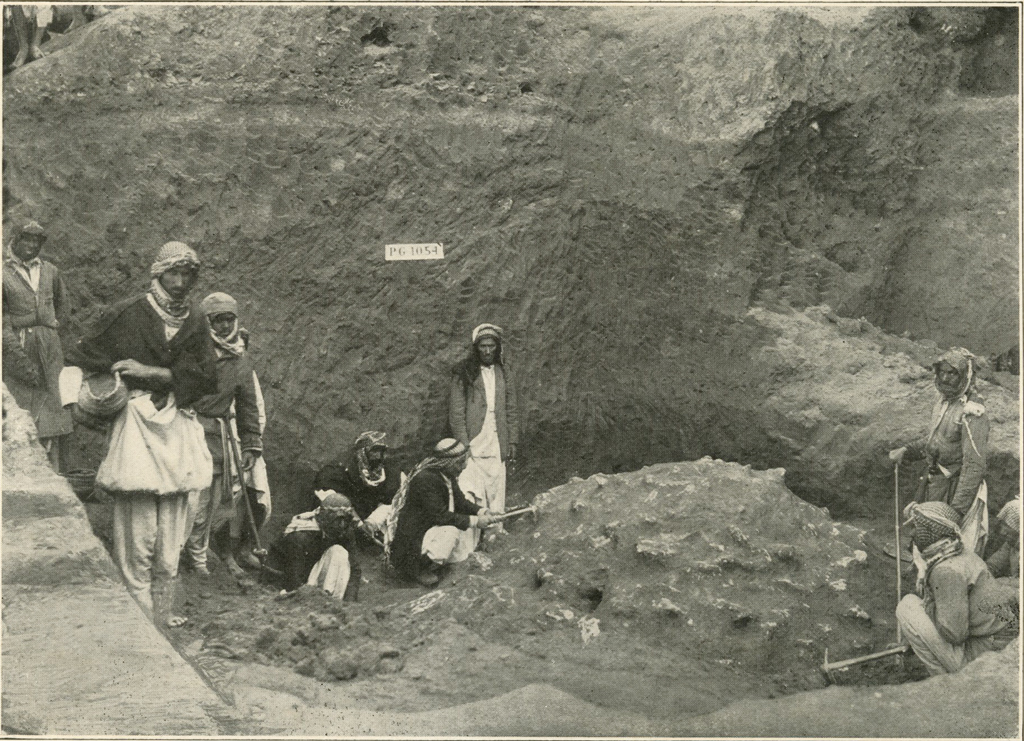
Image Numbers: 8993, 191167
Considering how elaborate the tomb structure was, the contents were simple. Below the woodwork, which seems to have been a canopy, there lay six bodies of which four were servants or soldiers, men distinguished only by the wearing of copper daggers, and one apparently a maid servant ; the sixth body, laid out in the centre, was that of a woman wearing a wreath of gold beech leaves and another of ring pendants strung on carnelians, gold earrings, finger rings, necklaces of gold and carnelian, gold hair ribbons, and a frontlet decorated with a star rosette and secured by long gold wires; on the breast was a carnelian-headed gold pin of the bent type not hitherto found in precious metal, and a gold cylinder seal having two registers of design in one of which is shown a banquet and in the other musicians playing on harps and other instruments; by the hands was a fluted gold tumbler much like that found in Queen Shub-ad’s grave but not quite equal to it in quality. The bodies rested on a floor of mud bricks and smooth clay; this was curved so as to present the appearance of a vault and gave out a hollow sound when hit; it was therefore lifted, and below it was found a stratum of broken pottery and a very large vertical drain, which, however, only went down some fifty centimetres into the soil; below it there seemed to be the original debris in which the early graves are dug. The excavation of the tomb is not finished, as the court in front of the door of the domed chamber has yet to be cleared: further work should throw more light upon what are the most completely preserved though not the richest of the royal graves, but already we have evidence of a much more complicated ritual than could be deduced from last year’s results.
Private Graves
Of the private graves one of the best was that of a very young child perhaps three or four years old. Besides a set of stone vases the little shaft contained a group of miniature vessels in silver and on the body were miniature gold pins, while on the head was a miniature wreath of gold beech leaves, another of gold rings, and one with pendants of gold, lapis, and carnelian. Another child’s grave contained a fine head ornament, a chain of triple beads in gold, lapis, and carnelian, with a large gold roundel of cloisonné work and two others of wire filigree. A woman’s grave produced, together with many other objects, the remains of a harp similar in type to that of Queen Shub-ad though simpler in character, in that it had no animal’s head and was decorated with silver instead of gold; a very important feature was that the woman wore on her head, as well as the normal beech leaf and ring wreaths, a diadem decorated as was the second diadem of Queen Shub-ad, with pomegranates and figures of animals in gold over a bitumen core; the workmanship is much inferior, but the parallel is very striking.
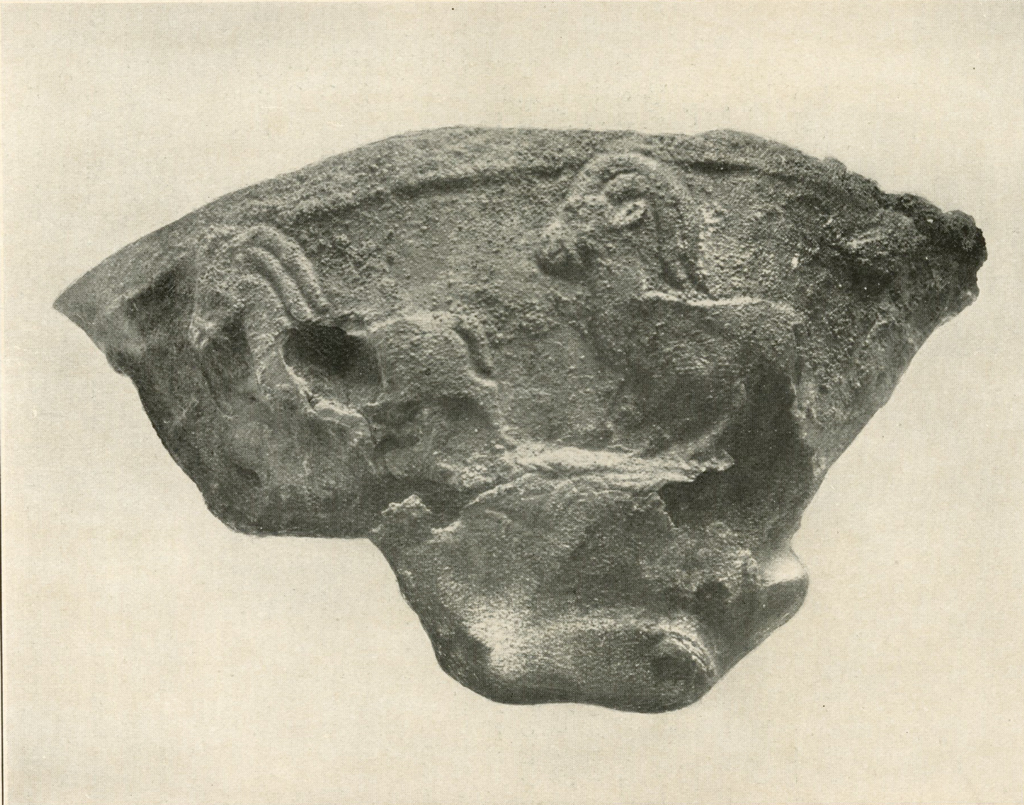
Image Number: 9008, 191183
A very interesting discovery was that of another harp. Two holes in the soil were noticed by a workman and after examination were filled by me with plaster; the earth was then cut away and more plaster work was done where the decay of woodwork had left hollows. The result was a complete cast of a wooden harp decorated with a copper head of a bull. Further clearing exposed the remains of the actual gut strings, mere hairlines of fibrous white dust but, even in the photograph, perfectly clear as the ten strings of the instrument. It was the more interesting as this is a harp not of the type of that found in Shub-ad’s grave but resembling those figured on the shell plaque from the gold bull’s head found last year and on the ” standard,” having the strings attached by tying (not by metal keys) to a horizontal beam.
The grave with the ruined harp of the type of Shub-ad’s also produced a silver bowl, unfortunately in very bad condition, decorated with a design of wild goats in repoussé work walking over mountains represented in the conventional way by engraved lines; this is the first example that we have found of this technique in silver. Another technical novelty was given by the imprint on mud of a piece of wooden furniture, itself completely decayed, decorated with engraved designs (the engraved lines filled with colour as in the case of shell plaques) and with carving in low relief; the possibility of ever finding the actual wooden objects preserved is so small that evidence of their character is the more interesting.
An alabaster lamp with a figure of a man-headed bull carved in relief on its base shows a variant from the type given by a similar but later lamp found last season. Perhaps our best object is a copper sculpture in the round of a human head with bull’s ears and horns, probably a unique piece; this was found loose in the soil, not associated with any grave, and its use is also uncertain.
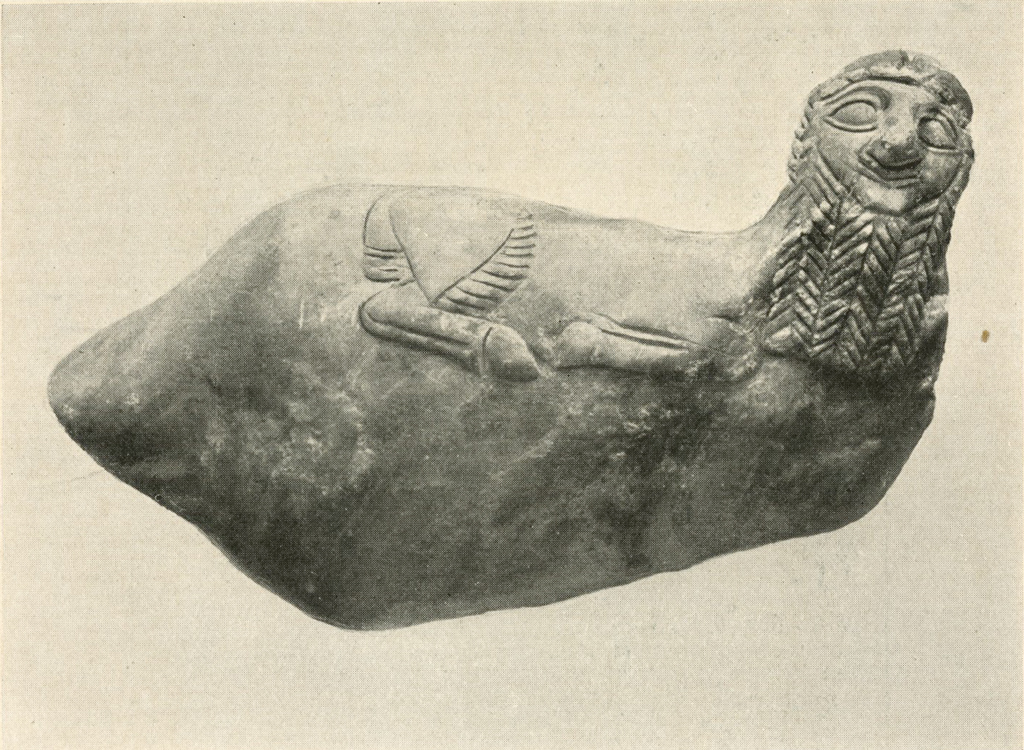
Image Number: 9009
Third Shaft: Harps and Ram Statues
In one part of the work there had been for a long time signs which seemed to portend a royal tomb and at last the pick-men detected the shelving sides of an ancient pit-shaft. As the filling of this was removed we found that only one end of the shaft lay within the area at present being cleared, the rest ran on under the twenty-five feet of earth where as yet no digging had been done, so that for the moment we could clear no more than a section of a shaft whose total area must remain unknown. The rim of a very large copper vessel was the first thing to be found, then another appeared next to it, and then the black stain of decayed wood; very careful clearing laid bare the wheels of a wagon, a perfect impression of a thing which had itself long since vanished, but on the soil could be distinctly seen the grain of the different planks of which the wheel was made, the curve of the rim and the stump of the axle; in front of it, in the part which we could excavate, lay the skeletons of two asses and a groom and amongst the bones the line of silver and lapis lazuli beads which had decorated the reins: it was just such a wagon as we had found in the king’s grave last season.
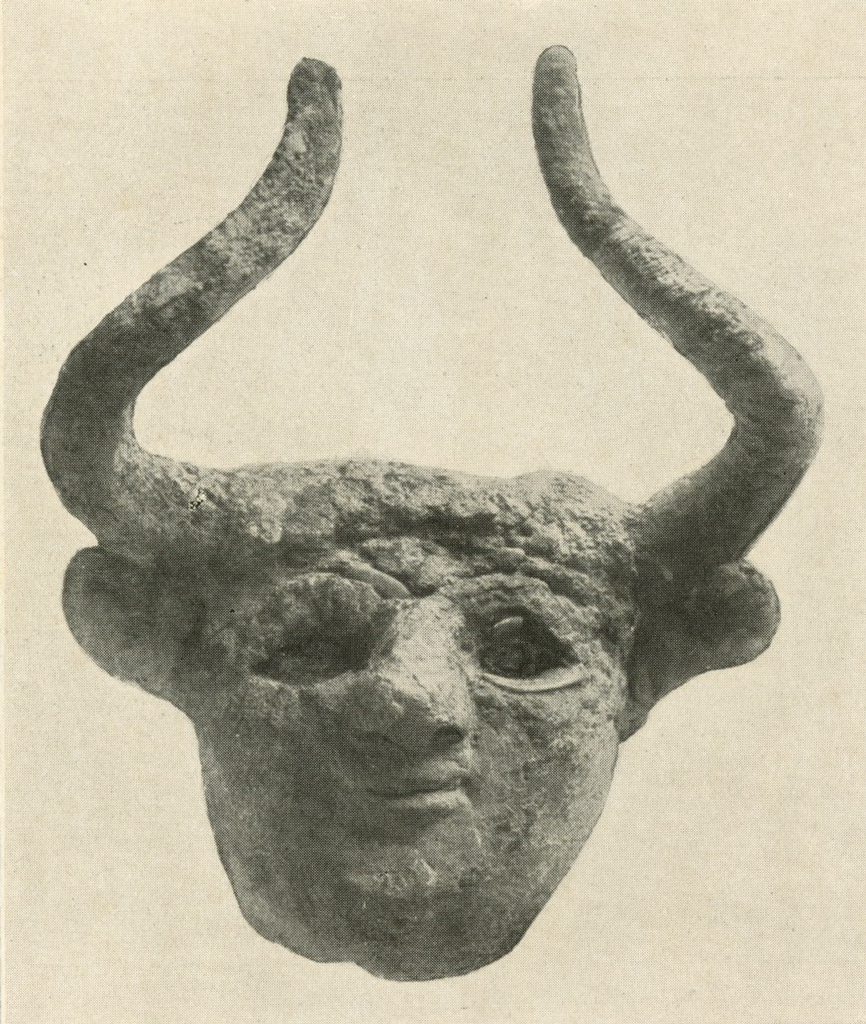
Image Number: 9016
The mud floor on which the wagon stood had been covered with matting and towards the sides of the shaft this rose steeply up as if in the centre it had sunk beneath the weight of the wagon and its team. That could only have happened if the soil beneath them was soft and had recently been disturbed, so we dug down by the side of them and discovered some three feet below, the skeletons of other animals, sheep and cattle, a collection of copper vases and weapons, and the bones of a man. Here was a novel feature; the bodies of the victims and the offerings had been placed in the grave pit, earth had been heaped above them and stamped down and mats laid over the top, and thereafter the wagon had been driven in and the slaughter of beasts and of grooms had been a later act in the burial tragedy.
It was probable that the wagon stood immediately in front of the entrance to the shaft, so digging was continued behind it and the sloping earth side was traced back for some distance; but to our surprise this proved to be the side not of a narrow passage ramp but of a pit some twenty-five feet square, a “death pit” larger than any we have yet encountered, and the whole of this is covered with the bodies of human victims laid out in ordered rows. For more than a week we have been at work clearing the last nine inches or a foot that covered the floor of the shaft and a third of the space still remains to be examined, but already we have listed forty-five bodies, of which thirty-nine are women and six are doubtful. And the riches of them are astonishing. In the king’s grave last year we found nine court ladies wearing headdresses of gold and semiprecious stones; here there are already thirty-four such, and for the most part far more splendid—the best only less remarkable than the headdress of Queen Shub-ad herself, gold hair ribbons, wreaths of gold leaves and flowers, inlaid pendants, great lunate earrings, silver “combs” with flowers of coloured inlay, pins of silver or gold, necklaces of gold and lapis row upon row, a wonderful group of regalia. Nor are these all the contents of the pit. In one corner there lay folded up on the top of the bodies a sort of canopy whose ridge-pole was decorated with bands of gold and coloured mosaic over silver and the uprights were of silver with copper heads in the form of spear-points hafted with gold, while shell rings held up the hangings. In another corner were harps. Of one the sounding-box was decorated with broad bands of mosaic, the upright beams encrusted with shell, lapis lazuli, and red stone between bands of gold, the top bar plated with silver; in front of the sounding-box was a magnificent head of a bearded bull in gold and below this shell plaques with designs picked out in red and black. A second instrument of the same type was entirely in silver relieved only by a simple inlay in white and blue and by the shell plaques beneath the silver cow’s head in front of the sounding-box. Below these was found a third harp of a different sort; the body, made of silver, was shaped rather like a boat with a high stern to form the back upright; the front upright was supported by a silver statue of a stag nearly two feet high whose front feet rest in a crook of the stem of a plant, made of copper, the long arrowlike leaves of which rise up on each side level with the horns. An exactly similar figure of a stag but made of copper and mounted on a square copper base lay alongside; possibly it was the decoration of yet a fourth harp the body and uprights of which had been of wood, now decayed; unfortunately the copper too was terribly perished, and though we succeeded in lifting it it can never be more than the wreckage of itself, whereas the silver animals, though crushed, are on the whole very well preserved.
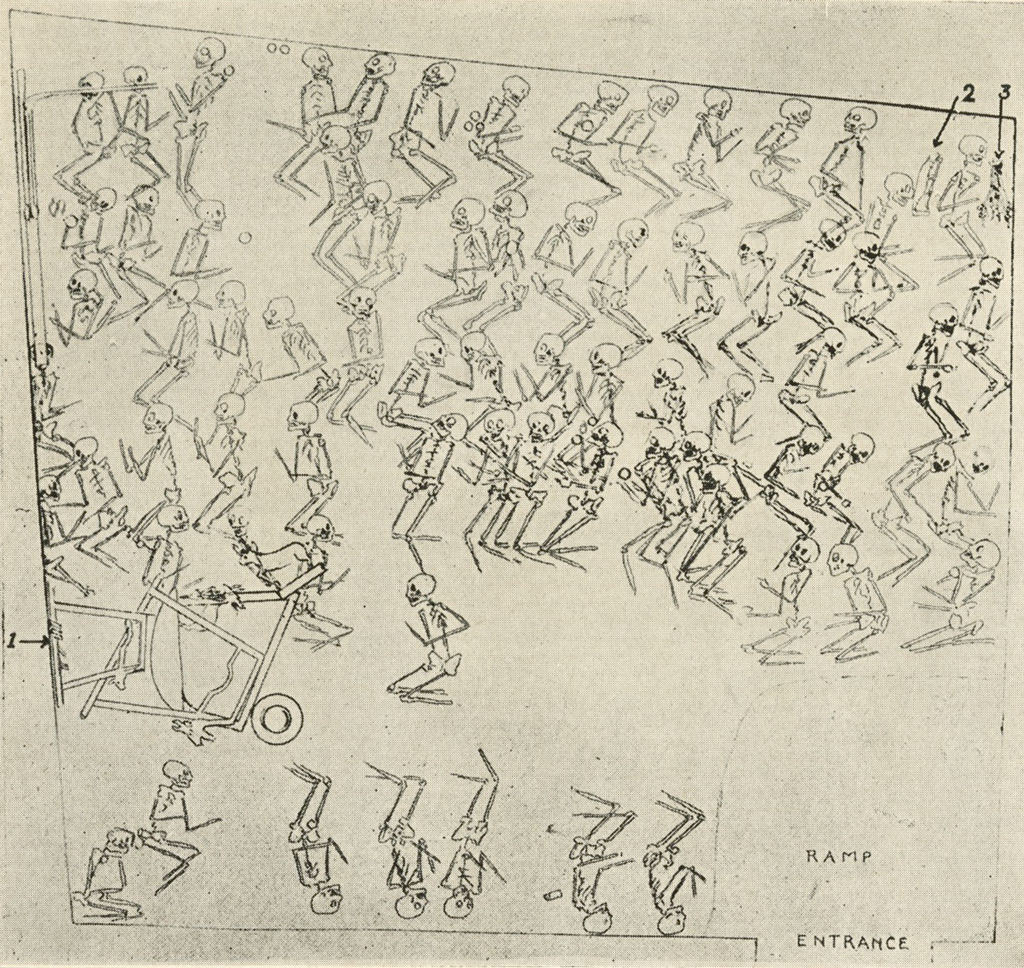
Image Numbers: 191331, 191207, 141592
Another corner of the pit yielded two objects absolutely unique in our experience—a pair of statues in the round of rampant rams. The heads and legs of the beasts are of gold, the horns and the long hair over the shoulders are of lapis lazuli, and the fleece over the rest of the body is of white shell, each tuft carved separately; the belly is of silver. The animal is reared right up on its hind legs, so standing twenty inches high. On either side of it are tall plants whose stems, leaves and large rosette-like flowers are of gold, and to the stems of these the front legs of the ram are tied with silver bands. The composition is precisely that to which we have been accustomed by the engravings on shell plaques, but here we have it executed in the round, on a large scale and in precious materials; the workmanship is admirable and the colour scheme is most striking. Baroque as they are, these gay statues seem to be rather of the school of Benvenuto than products of early Sumerian art as we should have imagined it. It should be added that they are to be judged not as free art but applied, for a socket above the shoulders of each ram shows that they were really the supports for some article of furniture or ornament which has disappeared, leaving no more trace of itself ; whatever it was, it was a very gorgeous object.
The “death pit” has still to be cleared of its remaining gold. In the meantime we are digging down from the modern surface in the hopes of finding beneath it the actual tomb to which this should be the introduction.
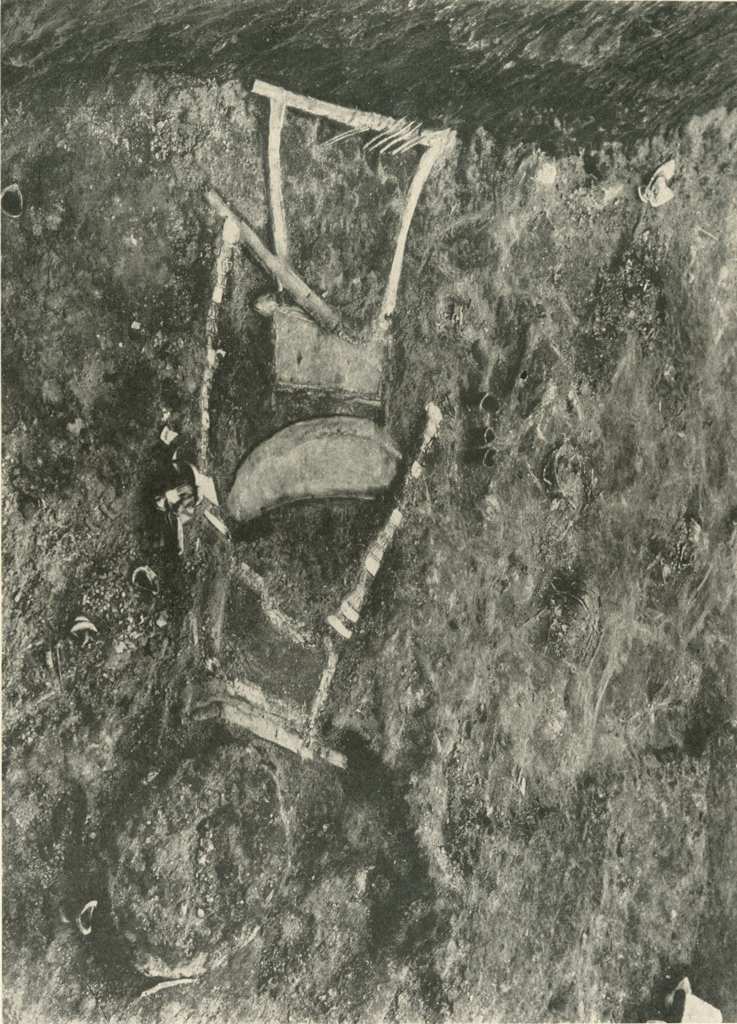
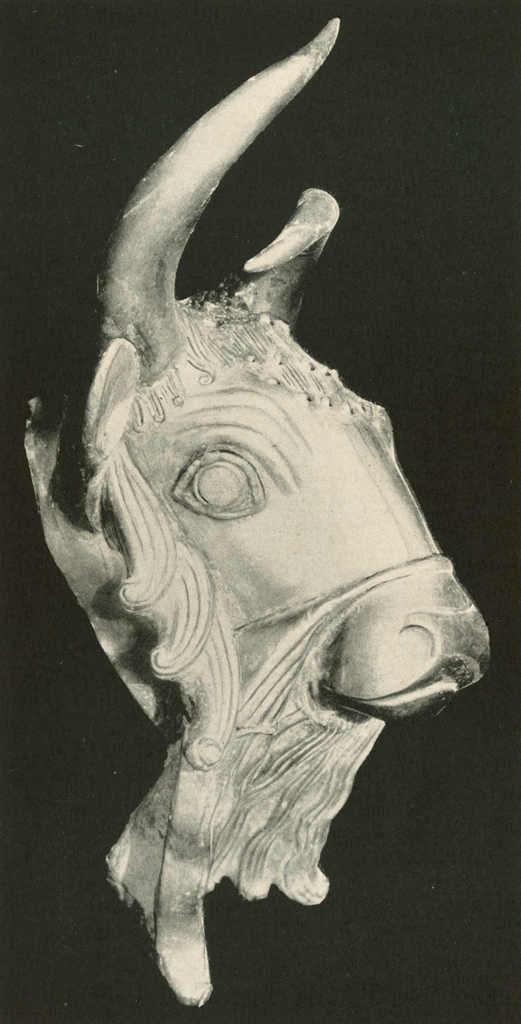
The Great Stone Tomb
With the clearing of the “death pit” we finished up the area selected for the first stage of our season’s dig. The number of graves dug this season already exceeds three hundred and fifty, and the small objects from them have been excellent. Starting on a fresh section of the graveyard we obtained from the outset a piece of interesting information. Below the mud-brick Temenos Wall of Nebuchadnezzar, which we had to cut away, there lay private houses of the little known Kassite period (ca. 1700-1200 B. C.), proving that Nebuchadnezzar did not simply follow tradition but enlarged the sacred area of the city, probably so as to include new temples of his own founding. These buildings, and the brick tombs which lay beneath their floors, had disturbed the upper levels of the older cemetery, but in spite of this the ordinary graves of the Sargonid age (c. 2700 B. C.) produced, as we dug deeper, their accustomed
harvest of gold and silver ornaments, stone vases, and copper weapons, and those of the First Dynasty of Ur, five hundred years older and lying lower down in the soil, were not less rich. Much more important was a royal tomb which underlay the rest. It was a single building measuring forty-two feet by twenty-six, built throughout of unhewn limestone ; it contained four chambers, two small central rooms roofed with ring domes and two long flanking rooms with corbel vaults, all communicating with each other by arched doorways : inside, the roughness of the walls was disguised by a smooth cement plaster, and the same plaster was used for the floors. The tomb is indeed an underground house, and this fact throws new light on the beliefs of the oldest Sumerians and should explain why the dead king was accompanied by such a crowd of courtiers and domestics—his life was to continue in surroundings as like as might be to those of this world. Of the servants and court attendants there remained in this case little but scattered bones, for ages ago robbers had broken through the roof of the tomb and made a clean sweep of its contents. Some of the necklaces torn from the bodies had broken, and the floors were littered with lapis lazuli and gold beads, two silver lamps lay overlooked in a corner, there was a broken sceptre of mosaic work with gold bands decorated with figures in relief ; but the great treasures which the tomb must have contained had vanished. It was a disappointment of course, but we had the satisfaction of having found the tomb itself, a first class monument of this early age. How much the robbers had actually taken one can only guess, for not all the royal graves were as rich as Queen Shub-ad’s; we have just laid bare one “death pit” in which the ranked bodies were all quite poorly attired, with a few silver ornaments in the place of gold; but the pit rewarded us well, for against its edge stood a harp with a particularly fine calf’s head modelled in copper and on the front of the sounding box a panel of mosaic work with human figures in shell set against a background of lapis lazuli, the technique of the wonderful “standard” discovered last season.
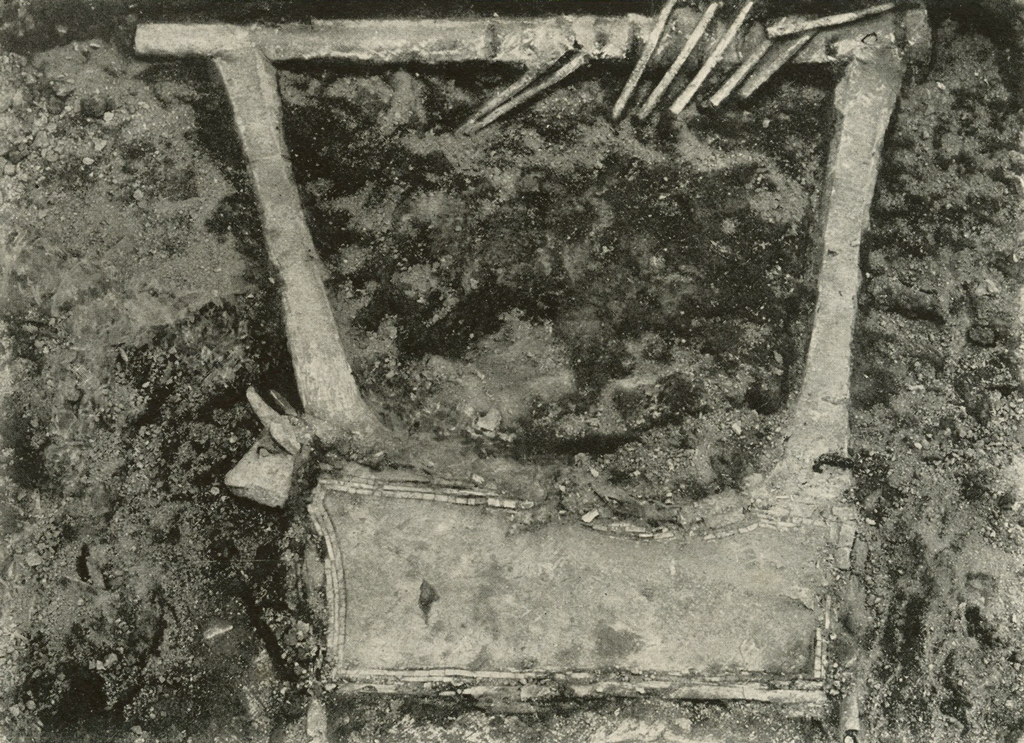
Deeper Level and Oldest Tablets
Here too another discovery was made. The graves are all dug down into a vast rubbish heap which sloped down from the walls of the earliest Sumerian settlement to the marsh or river out of which it rose, and the bottom of this particular “death pit” just touched a stratum of rubbish, necessarily very much older than itself, wherein lay multitudinous nodules of dark-coloured clay; many were shapeless, but amongst them were written tablets and clay jar-stoppers bearing the impressions of archaic seals. Not so old as the pictographic tablets of Kish, which we may expect to parallel from the deeper rubbish strata of Ur, these documents carry us back to a period in the city’s existence not yet illustrated by any other class of objects except crude figurines in clay of animals and men from which it would have been impossible to deduce the level of culture attained at the time.
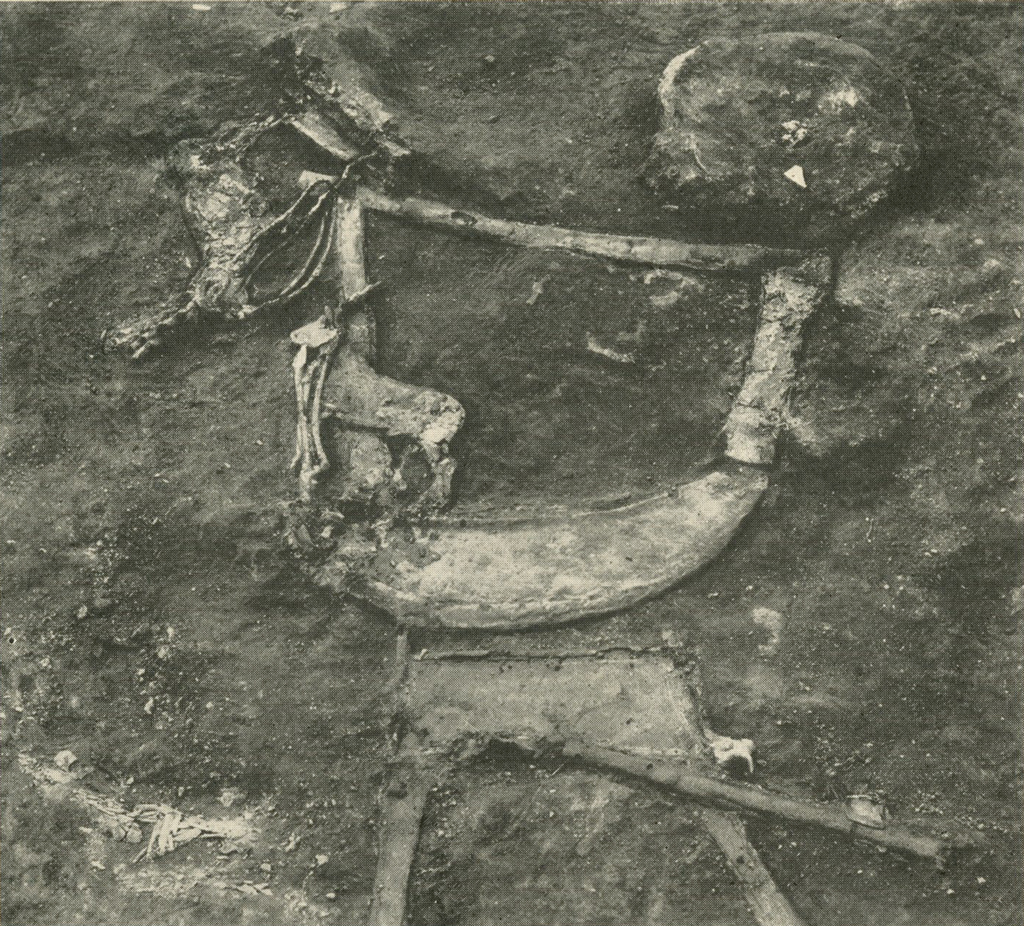
Limits of the Cemetery: the Prehistoric City
The excavation of the ancient cemetery came to an end early in February and it was characteristic of the site that the very last grave discovered should be the richest of its period yet brought to light. It was of the Sargonid age, about 2650 B. c., and was that of a man, judging from the number of copper weapons placed at the head and along the side of the wooden coffin in which were the crumbling bones; amongst them were three of the largest spears that the cemetery had produced and with them a number of copper vessels, some unusually large, and a copper tray made to imitate basket-work and piled with bowls and vases of novel forms. Six gold fillets adorned the head of the man and round his neck were three strings of beads of gold and coloured stone, agate, carnelian, jasper, chalcedony and sard, stones which are rarely found before the time of Sargon of Akkad. On the wrists were four heavy bangles of gold and four of silver, and on the fingers were gold rings; by these lay two engraved cylinder seals of lapis lazuli capped with gold, and from one of the strings of beads hung a gold amulet in the form of a standing goat exquisitely modelled in the round, a real gem of miniature sculpture.
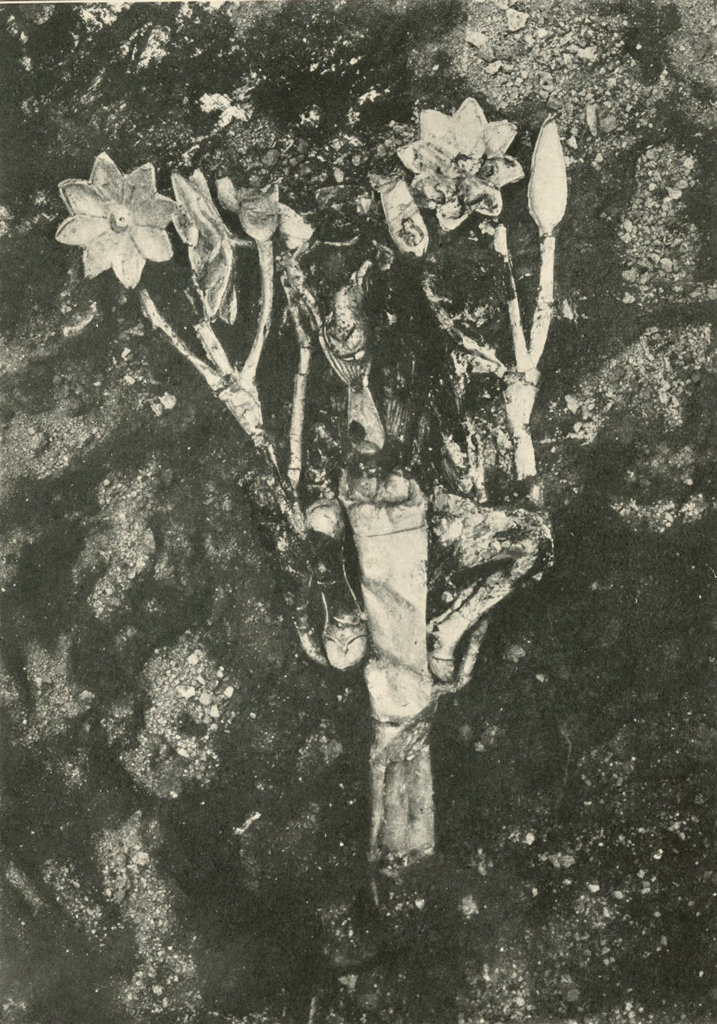
Museum Object Number: 30-12-702
Image Number: 8999
Having exhausted the graves in the area selected for this season’s work we proceeded to dig down beneath them for relics of the older civilization represented by the great rubbish heaps in which the graves are set. In a stratum of this rubbish which is late in comparison with much that lies beneath it but very much earlier than the oldest graves, we were fortunate enough to find in a ruined house (for at one time the primitive settlement overflowed its normal limits and houses were constructed on the slope of the town’s refuse dump) some two hundred tablets written in a very archaic script, one of the oldest forms of writing known in Mesopotamia.
Meanwhile work on the other side of the excavated area proved the northwest limits of the cemetery also. Our work here produced no graves but either stratified rubbish or superimposed house remains according as the limits of the early town fluctuated in times of greater or less expansion. Near the surface we came on a pavement of plano-convex bricks which could be dated as not later than 3000 B. c. and we dug down through successive floor levels to a depth of eight metres below this, by which time we were finding very early seal impressions on clay and pottery, painted or otherwise decorated, of types elsewhere occurring only below the ten-foot bed of clay which I have regarded as a relic of the Flood. For the full working out of the earliest history of Ur excavations on a large scale ought to be undertaken either at this spot or a little to the northwest of it.
With regard to the ancient cemetery lying on the slope below the walls of the settlement, we now know its width and further excavation of its length in either direction (probably little remains to be done to the northeast) can be carried on economically and with proper knowledge.
The Walls of Ur
Thoroughly to work out this prehistoric site was a task far too big to be tackled at the close of a season: content for the moment with the very important preliminary results which we had obtained, we turned our attention during the last ten days to the city wall, again with the idea not of complete excavation but of securing information which would enable us to draw up programmes for future digging. The results were immediate and surprising.
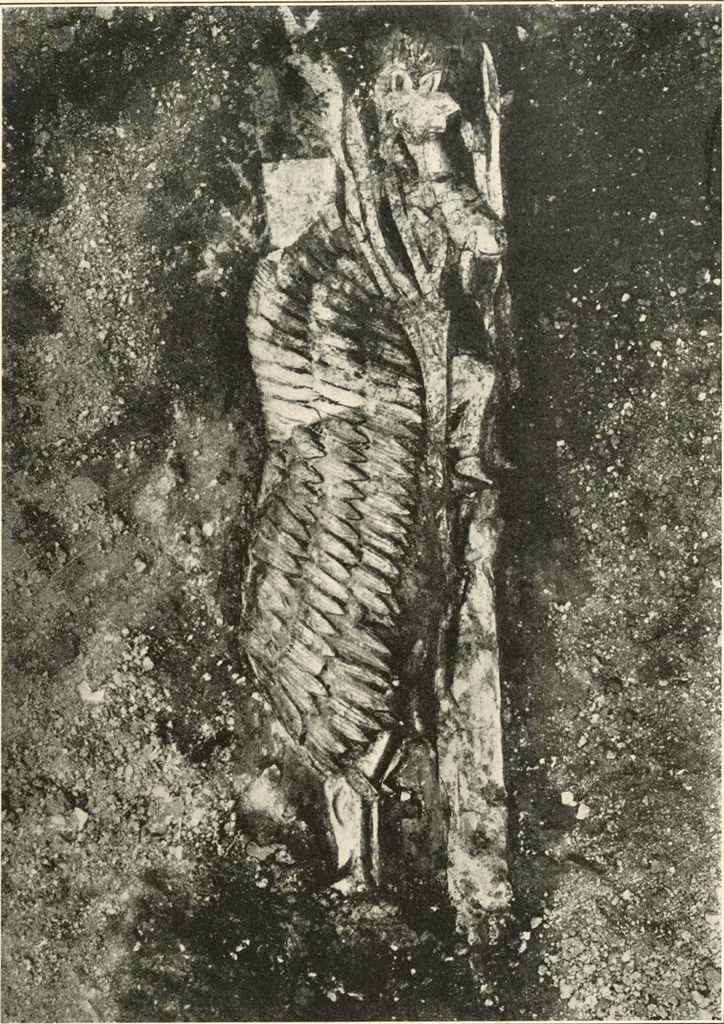
Museum Object Number: 30-12-702
Image Number: 142256, 8998
The spot chosen was on the northeast side, just behind the Expedition house.
Two days’ work sufficed to produce the real town wall which has a total width of more than twenty-eight metres and is still standing more than eight metres high: we were able in the few days that remained of the season to follow it in both directions for a distance of over a hundred metres and to establish something of its character and history.
Apart from a few literary references to its building and destruction we knew nothing about the wall. More than this, very little is known at all about Sumerian defences, seeing that no expedition has yet undertaken the heavy task of clearing the circuit of an ancient town.
At Ur, the centre of the site is surrounded by a ring of mounds, not continuous, for whereas in some parts they stand high and present on the outside an abruptly sloping face, in others they sink to the level of the plain or are so confused by adjoining mounds as to lose all character: but even from the ground something in the nature of an outline to the inner city detaches itself from the tangle of slopes and hillocks, and an air photograph shows much more clearly what can only be the defences of the town. The enclosure is an irregular oval about three-quarters of a mile long by half a mile wide; outside it the suburbs stretch for miles, inside it, like the citadel inside the bailey, lies the Sacred Area wherein most of our excavation has been done; within the enclosure levels average higher than outside and it is reasonable to suppose that it represents the oldest settlement ; certainly it remained throughout history the administrative and religious centre.
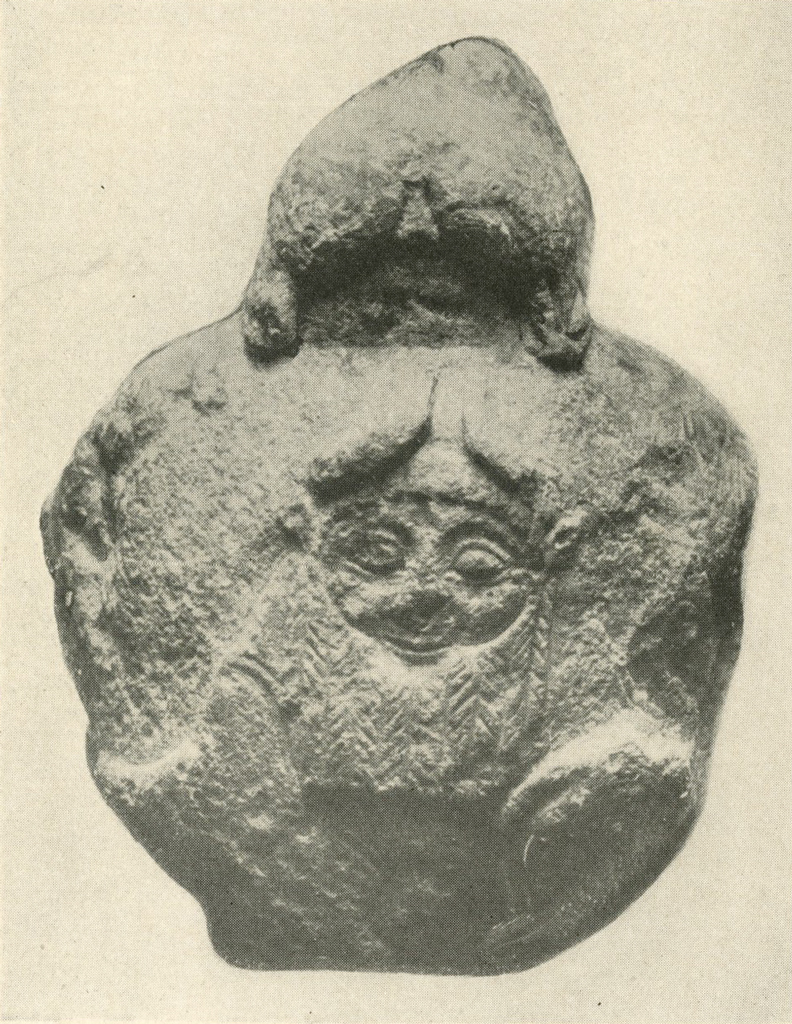
Image Number: 191241, 9015
The fortifications of the city were, naturally enough, repaired or reorganized a number of times; the earliest work that we have found dates to the Third Dynasty of Ur and is probably due to the founder of the dynasty, Ur-Engur (2300 B. c.), who explicitly claims its construction; we have reconstructions and additions by kings of Larsa (circ. 2000 B. c.), by Kuri-Galzu of Babylon (1400 B. C.), and by a later king whom we have not yet identified. Ur-Engur’s wall seems to have consisted of two parts, a lower wall of crude mud brick and an upper wall of burnt brick of which, in the section cleared by us, nothing at all remains. But the mud-brick wall is an amazing structure. It stood some twenty-six feet high, its back vertical, its outer face sloped back at an angle of forty-five degrees, and at its base it measured not less than seventy-five feet in thickness! Really it served the purpose of an earth rampart along the top of which ran the wall proper, but it was itself built entirely of bricks carefully laid. Behind it the floor level was raised about twelve feet above that of the plain outside, though whether this was continuous over the city area or was in the nature of a platform backed against the wall we cannot yet say; judging from surface indications the former would seem to be the case. The sloped mud face of the wall must have suffered badly from weather and it was twice reinforced with revetments which added another eighteen feet to the wall’s thickness; the authorship of these is still uncertain, but the first addition may well have been due to the Larsa kings part of whose superstructure is well preserved. In their time the levels inside the wall had risen almost to the top of Ur-Engur’s mud brick. So far as the inner face of this showed, they revetted it with burnt brick and set up along the top of it a continuous row of buildings which served a double purpose; they were at once the burnt-brick wall crowning the rampart and living accommodations for citizens or officials, for their inner ground-plan is exactly that of the private houses excavated by us on the other side of the Temenos; in spite of their position and the fact that they are built to a general plan with bricks bearing royal stamps, there is nothing military about them. One is reminded of Rahab who dwelt upon the wall of Jericho and of some mediaeval city like Aleppo where the solid masonry of the ramparts rises up to merge insensibly into the flimsy window-broken backs of private houses.
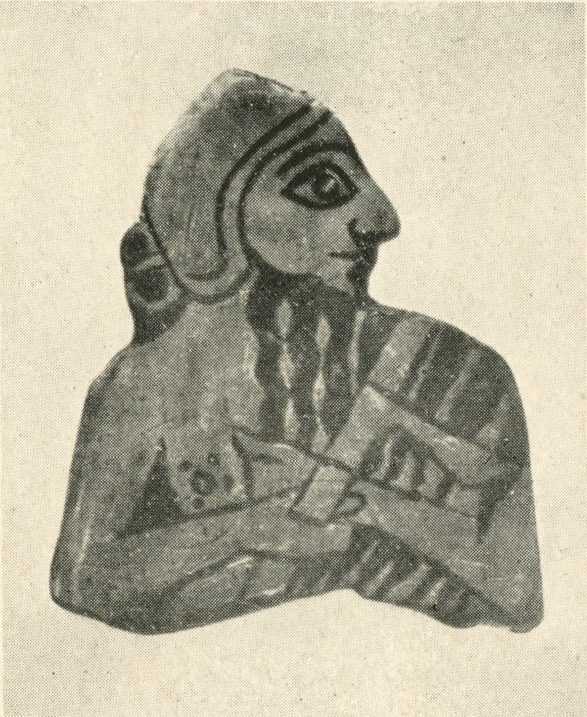
Image Number: 9011b, 9012b
We know that after a revolt against Babylon the “great walls of Ur” were destroyed by Hammurabi’s son in about 1870 B. C. Then, and in the course of the next four hundred and fifty years, even the lines of the superstructure must have vanished, for we find a great gate-passage of Kuri-Galzu running athwart everything. It was strongly built with burnt bricks a large proportion of which bear his name, but everything else of his work has been destroyed by a later building, a fort lying inside the wall and probably (though our work has not gone far enough to prove this) flanking one of the city gates. Only the mud-brick substructures of this are left together with the burnt-brick facing of its outer wall on the northeast, but the foundations show that it was extraordinarily massive, even the inner walls being never less than thirteen feet thick. Notwithstanding this it appears to have been considered insufficient for the city’s safety, for close to it on the northeast, just outside the lines of the old wall, we have exposed the greater part of a second external fort obviously of the same date though also of unknown authorship. It is a rectangle with double gateways leading to a central court ; the walls, of burnt brick, are over twenty feet thick; it seems to be such a tower as we might expect to find guarding the entry to the town.
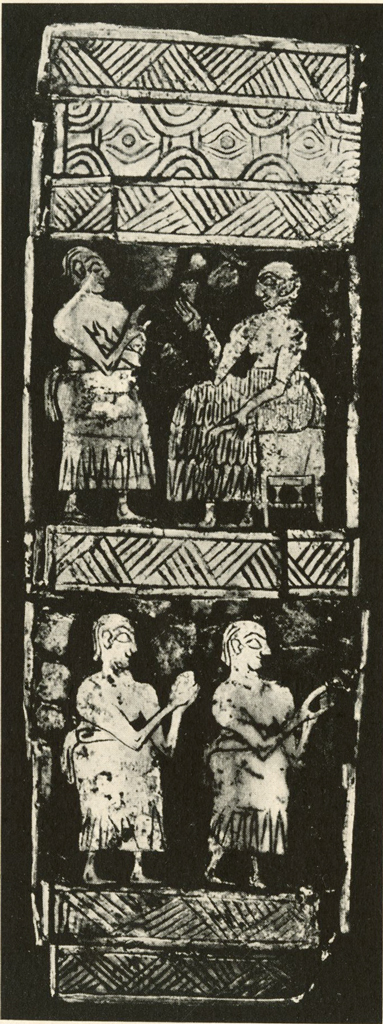
Museum Object Number: 30-12-484
Image Number: 9011a, 9012a
Under the floors of the Larsa superstructure there were many tombs of the period, and later graves, mostly of Neo-Babylonian date, were found higher up; these produced a good deal of glazed pottery and a few other objects. From one room we recovered a collection of tablets, apparently business documents in envelopes, of Larsa date; the packing of a drain yielded an unusual object in the form of a fragment of a large stone jar bearing an inscription of Dungi; and in the foundations of the late fort was found a small female head carved in the round from grey stone, with inlaid eyes, very much in the style of the marble head with inlaid eyes discovered three years ago, but smaller and not quite so good.
If we clear the whole circuit of the walled town, as we ought to do, we shall not only have a very wonderful monument—our present work shows that—but for the first time we shall obtain an adequate picture of the system of military defence employed by the great builders of Sumer.
Great Court of the Temple
Work on the Nannar Temple has been of a very different sort and deals with much later dates. On Mr. Mallowan’s arrival on the tenth of December, I engaged a fresh gang of fifty men and put them in his charge for the clearing of the chambers along the front of the temple, the courtyard of which we had cleared last season.
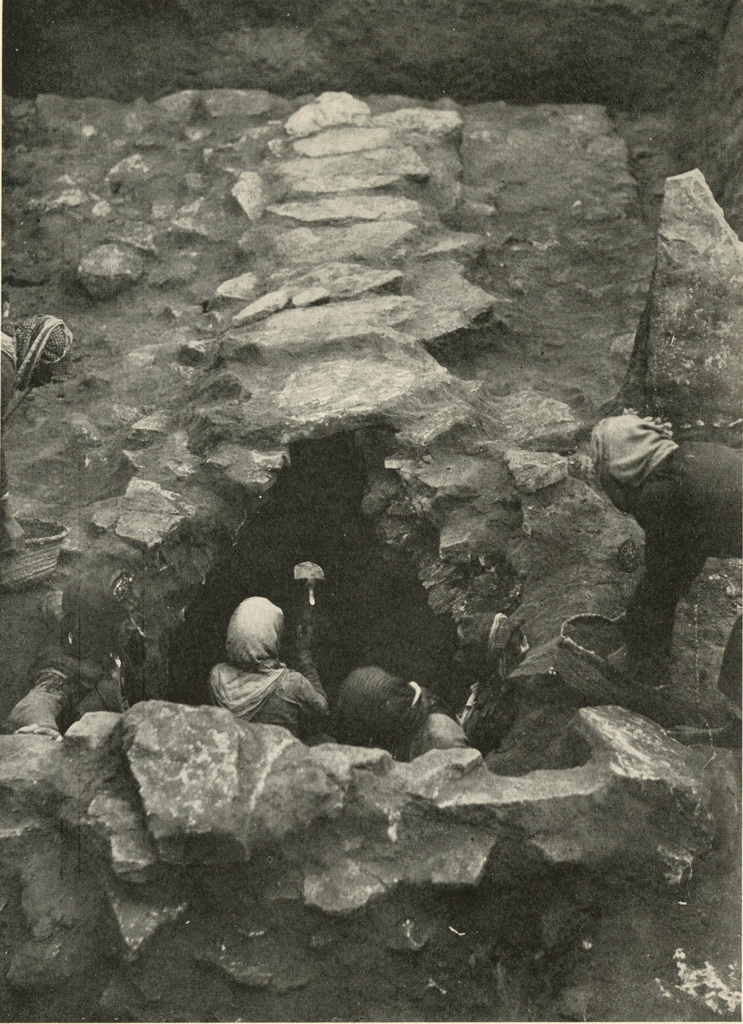
Image Number: 8994
The general character of the building was already known from surface clearing; our object this year was to trace the details of its history, and in this we have been eminently successful. Vague fragments of wall were unearthed which belong to about 3000 B. C. and tell of a temple of the Moon God lying at the foot of a smaller and an older ziggurat than that which we see today. Ur-Engur built the present ziggurat and laid the foundations of the great temple to the patron deity of his city; the sanctuary lay against the northwest side of the tower, the huge outer court formed a lower platform whose containing walls covered a much wider area than the old temple. Ur-Engur did not live to finish his work, and his son Dungi built the superstructure, the pylon gateway at the entrance of the temple and the range of chambers which surrounded the courtyard on whose pavement stood the altars or bases of his father and himself and, in time, of his son Bur-Sin. After the downfall of the splendid Third Dynasty of Ur a king of Isin filled up half the courtyard with a massive brick structure whose meaning is not yet clear to us, and a later ruler, Sin-idinnam of Larsa (c. 2000 B. C.), blocked the court still further with a base whose foundations go down to prehistoric levels. But these were minor changes; it was left for the Elamite king Warad-Sin to remodel the whole temple. He enlarged the building in three directions, putting up a new retaining wall for the terrace outside the old wall the stump of which was buried under the floor of his chambers, and the whole of the exterior and the wall of the courtyard facing the entrance were enriched with half-columns and recesses of burnt and crude brick. Five hundred years later what remained above the ground of Warad-Sin’s work was dismantled and on its foundations Kuri-Galzu II of Babylon (c. 1400 B. C.) set up a plainer replica of the Elamite temple; much of the existing building is due to him. Apart from minor details, such as the repaving of the court by another Babylonian king about 1180 B. c. and the raising of its level by the Assyrian governor Sin-balatsu-ikbi in the seventh century, the temple retained its character until the time of Nebuchadnezzar (600 B. C.). He built two new sanctuaries on the ziggurat terrace, raised the pavement of the great court virtually to the same level and added to the pylon gateway by bringing it forward into the court, with side doors to the northeast range of chambers which he masked by a curtain wall. The rooms cleared so far have not produced any tablets; two inscribed door-sockets have been found, but the best object is one which has no real connection with the present building, a limestone mace-head with figures of man-headed bulls in relief and an inscription, unfortunately much defaced, which may refer to a king of Mari and certainly belongs to about that period.
Thus we can now trace through its long life of two thousand five hundred years the vicissitudes of the greatest temple of Ur, and with its excavation have practically finished our work in this part of the city.

